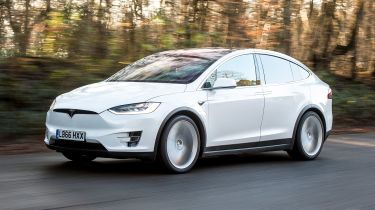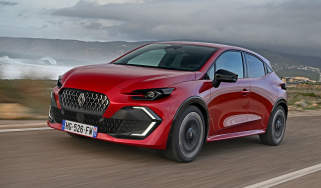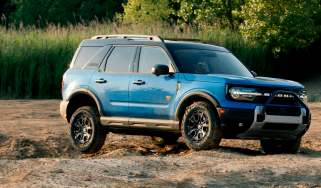Tesla Model X (2016-2025) review
If you want a ludicrously quick crossover with all-electric drive and quirky doors, the Tesla Model X is it

The practicality of the Model X’s bodystyle means it will appeal to even more customers than its Model S sibling, while its stunning performance and useful range mean there’s little in the way of compromise.
There’s loads of space inside and the quiet, smooth and quick powertrain means it’s a great way to travel. It won’t appeal to keen drivers, but if you can afford the high prices then the Model X could just be the SUV for you.
About the Tesla Model X
Although Tesla calls the Model X an SUV, the car-like profile with sweeping rear roofline means it’s more like a crossover. All versions are four-wheel drive, but there’s no intention that the Model X should be driven off-road. On tarmac its acceleration is nothing short of astonishing, which forms a big part of the appeal.
Unusually-styled, the Model X's signature lifting ‘Falcon’ rear doors allow very good access to the second and third rows of seats – albeit with some significant compromises outlined below. Talking of seats, you can configure your Model X as either a five-, six- or a seven-seater depending on your family needs.
At a little over 5m in length, the Model X is an imposing sight although its bulky volume is less elegantly disguised than the Model S saloon which manages to look svelte. In spite of its extra size the two models share a platform and all their core engineering, from batteries to motors to the Tesla Autopilot self-driving tech.
Used - available now

2016 Tesla
Model X
61,490 milesAutomaticElectric
Cash £34,299
2016 Tesla
Model X
83,736 milesAutomaticElectric
Cash £22,990
2016 Tesla
Model X
53,280 milesAutomaticElectric
Cash £20,295
2021 Tesla
Model X
20,000 milesAutomaticElectric
Cash £39,995The fact it’s such a unique proposition means it’s hard to match the Model X up to rivals. Expensive full size SUVs with high performance and fuel-saving plug-in hybrid tech include the Audi Q7, BMW X5, Mercedes GLE, Porsche Cayenne and Range Rover Sport. Buyers on the hunt for an SUV with electric-only power also have the option of the Audi Q8 e-tron, Mercedes EQC, Jaguar I-Pace and the BMW iX.
Tesla updated the Model X in early 2021, and the most notable change was the replacement of the Performance trim-level with the 1,006bhp Plaid model - which now sits alongside the standard dual-motor car in the lineup. The Plaid powertrain is a three-motor set-up and was originally developed for the revised Model S saloon but, as the two cars use the same platform, it's ready and able to go straight into the Model X.
A light exterior makeover also kept things fresh with a redesigned front bumper and diffuser, along with new 22-inch alloy wheels, while the cabin received new tech such as a revised digital gauge cluster, a 17-inch infotainment screen and four wireless smartphone charging pads.
In 2023, Tesla made the decision that the Model X and Model S would no longer be sold in right-hand-drive form. These models are still being sold in the UK but only as left-hand-drive cars. This could dissuade some potential buyers, but used right-hand-drive examples are likely to see a sharp increase in desirability.
With the Model X being an exclusively electric car, there are no other powertrain versions available: your only choice is how fast and how far you want it to go. There are plenty of options to choose from, though, including the strangely named Bioweapon Defence Mode, which filters impurities from the air coming into the cabin, including, it is claimed, bacteria and viruses.
Electric motors, performance and drive
The first thing that most Tesla owners will tell you about is their car’s stunning acceleration, and the story is the same with the Model X. The SUV’s combination of instant torque from the electric motors and all-wheel-drive traction means it has incredible pace from a standstill, sending the fastest Plaid version from 0-60mph in just 2.5 seconds.
Supercars have slower figures than that, so for a heavy SUV to manage such a fast sprint is very impressive. What the figures don’t tell you, though, is how flat the car feels as it’s accelerating. There’s less of a feeling of the weight shifting to the back as you might expect when you plant the throttle, thanks to the low centre of gravity, but there’s also an almost complete lack of drama.
So while the figures look impressive, the reality is that the Tesla Model X is not as much fun as you might think - even if it does make overtaking at low speeds very easy. At higher speeds the power delivery is less significant, with the car feeling more like a normal, albeit powerful, SUV.
It’s a similar story when it comes to the handling, with the Model X being impressive for its size, if a little clinical. The low centre of gravity (because the heavy batteries are positioned low down in the floor of the car) keeps body roll in check, and there’s loads of grip.
Adjustable suspension and steering, with further options to lower and raise the ride height, are available - but while you can feel the change in height, the difference on the road isn’t huge. The steering is well weighted but vague - similar to the Model S saloon’s.
Engines, 0-60 acceleration and top speed
There are no conventional engines in the Tesla Model X, as it’s electric only. There are different models, however, which give different performance and range figures.
The Dual Motor version accelerates from 0-60mph in 3.8 seconds and has a 155mph top speed. Despite those impressive figures, it also has a claimed range of 348 miles.
The 503bhp Alfa Romeo Stelvio Quadrifoglio takes 3.8 seconds to reach 62mph, so the 2.5-second 0-60mph time of the top-spec Tesla Model X Plaid makes it not only one of the world's fastest accelerating SUVs, but one of the fastest accelerating cars in the world.
Range, charging and running costs
As there’s not so much as a piston or camshaft in sight in the all-electric Tesla Model X, owners won’t have to worry about mpg fuel economy figures or CO2, as both are nil at the point of use. Of course, charging up at home will incur some electricity costs, but a full charge should cost considerably less than filling up with petrol or diesel.
The real figure to look into with electric cars is the range - and the Model X has an impressive battery set-up. The Plaid manages a claimed 337 miles - which isn’t bad considering it can also hit 60mph from rest in just 2.5 seconds. The slightly slower Dual Motor version can travel up to 348 miles, according to Tesla.
These figures are impressive, and mean the Model X will manage most commutes easily – and for several days on the trot without a recharge, in many cases. If you’re going on a longer trip, there’s also an increasing number of Tesla Superchargers around the country, which are charging stations that provide up to 172 miles of range in as little as 15 minutes.
A home charger is also available, which will keep your car topped up overnight ready for the next day’s drive to work or school. While they’re not as fast as the Superchargers, they’re still useful for making electric car ownership more practical.
Insurance groups
With every model in the range offering incredible performance, at a high price, with plenty of new technology on board, it’s no surprise that the Tesla Model X follows the Model S in being insurance group 50 across the board. That means it costs a lot to insure, which could offset some of the running cost savings compared to a less powerful diesel or hybrid SUV.
Depreciation
Data suggests that the Tesla Model X is a pretty strong performer on the used market. The Dual Motor version should 57-60 percent its list price over three years and 36,000 miles, while the Plaid model performs a little better retaining 62-65 per cent over the same period.
To get an accurate valuation on a specific model check out our free car valuation tool...
Interior, design and technology
While the Tesla Model X is certainly distinctive to look at, with its rounded nose, swooping roofline and raised stance, we’d argue that it isn’t as slick as the Model S it’s based on. It looks more like a jacked-up saloon than a true SUV, and the blank nose looks oddly unfinished.
A refresh in 2021 brought slight changes to the exterior with a redesigned bumper and diffuser, as well as new 22-inch alloy wheels. Interior updates added a revised digital gauge cluster, a 17-inch infotainment system and four wireless smartphone charging pads. Passengers in the rear also benefit from a screen mounted in the central tunnel, so they can play video games or watch films.
Of course the most unusual detail about the Model X is the rear doors, which open outwards and upwards in a ‘falcon wing’ shape. It’s certainly a unique design choice, and some will love the oddball arrangement, but it does seem slightly out of place on a car like this.
Inside you’ll find the huge touchscreen display in portrait orientation on the dashboard, plus some Mercedes switchgear and a plush set of seats. There’s lots of room inside and the materials used look good, but the design is very plain. There’s none of the flair you’ll find in a Mercedes, despite some of the same parts being used here.
The large panoramic windscreen gives you a great view of the road and sky ahead, extending almost over the driver’s head. A special tint means there’s only slightly more glare from the sun than in a normal SUV, too.
Sat-nav, stereo and infotainment
The central screen is easy to use, and you control a huge amount of the car’s functions with it - including opening and closing all of the doors, moving the seats and changing the climate control. Doing so on the move is a pain, though, and we prefer using buttons and switches in that situation. There are almost no buttons inside the car, in fact - and that frustrates when the screen is booting up and you want to set up the air-conditioning straight away.
Sat-nav gets real-time traffic information, and there are regular over-the-air updates from Tesla to keep things up to date. In some cases these updates even add new features to the car. You can pair your phone with the quick-connect system in the centre console, too.
A large and powerful stereo system stretches across the top of the dash, and it sounds good - but on sunny days the perforations reflect onto the huge windscreen and reduce visibility.
Practicality, comfort and boot space
The Model S is already a practical saloon, so the jacked-up Tesla Model X is even more spacious. The batteries are under the floor, which means there’s space for two boots, one at each end, as well as the option for six or seven seats.
The falcon wing doors might look like they are straight off a supercar, but they do actually help with the car’s practicality. They only require a little space at the side of the car, and automatically stop when they reach a hard surface, so there’s no risk of damaging them. That does mean you have to stand away to allow them to open fully, though.
Opening the doors in a car park will mean it’s actually easier to get in and out. However there’s still a big problem and that’s the slow speed at which they open. If it’s raining you’re going to get wet while the doors edge their way upwards, and the loud beep that plays as they do so is annoying, too. It’s a feature that really feels like it was designed for Tesla’s home market and the sunshine of California.
The doors feel flimsy as well, wobbling in the wind and to the touch, even if there’s nothing to suggest that they’ll fall off. Someone may hit their head on them, though - and we’ve seen that happen plenty of times.
Dimensions and size
The Model X is just over 5m long and 2.3m wide, and it feels large on the road from behind the wheel. The seating position is comfortable, and visibility is decent with that huge panoramic windscreen.
The ride height can be set at a few different stages, going up from the lowest setting of 137mm to 211mm in the highest setting. It’s useful for switching between faster driving and areas with speed bumps or rough terrain, although the car isn’t intended for off-roading.
Leg room, head room & passenger space
There’s lots of room in the front seats and in the six-seater, the second-row seats are nearly as spacious. They’re adjustable, just like the front seats, so passengers are bound to find a good position to sit in. Headroom was good too, even for tall passengers.
The final row of seats are forward-facing, unlike in the Model S, but they are really only suitable for children. There’s poor legroom behind the second row, and we found our heads pressed against the hot rear windscreen. The seats are quite low too, so our knees felt too high up. Climbing in isn’t too bad, though.
Boot space
Fold down the rear seats and there’s an impressive 2,180 litres of space, and there’s a 187-litre boot in the front, too.
The boot floor can be brought up to eliminate the loading lip, dropped down for more storage or removed completely to create a deep space behind the seats.
In the six-seater version, luggage could easily slide and fall forwards into the cabin when the seats are folded down. This is because, although part of the floor is flat, it’s stepped and the front seats are on a lower level. There are hooks to secure loads, however, which will help stop this becoming a problem.
Reliability and safety
As a brand, Tesla finished in an impressive second place in our 2022 Driver Power customer satisfaction survey, and although the Model X itself didn't appear, the Model 3 was voted into ninth place on our list of the top 75 cars to own. The number of Tesla owners who reported a fault with their car in the first year of ownership was considerably high, though, at 44 per cent - this was more than any other manufacturer.
The Tesla Model X was tested by Euro NCAP in 2019 and it was awarded a full five-star rating. As well as a notable 98 per cent score for adult occupant safety, it scored an impressive 94 per cent for its driver assist systems. The individual scores for child occupant and pedestrian protection were 81 per cent and 72 per cent, respectively.
Safety kit includes side collision avoidance tech, automatic emergency braking, blind spot warning and parking sensors. There’s also Isofix child seat mounting points inside for car seats. Tesla also includes Autopilot software with the Model X, which helps drive the car on motorways for you.
Warranty
While the eight-year, 150,000-mile warranty for the Model X’s battery and drive unit is reassuring, the four-year, 50,000-mile warranty on the rest of the car is a little disappointing. Many drivers will cover that mileage in four years, leaving them with a car out of warranty that many garages around the country can’t repair. They may end up paying high prices at Tesla dealers, but that said, Tesla claims to run its service centres at cost and not for profit.




